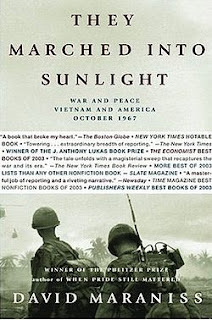Thanks to BBC4 I have now been able to see the 2005 documentary How Vietnam Was Lost: Two days in October.
The idea that a war that lasted for more than ten years had a pivotal moment, other than the one when the US fled from Saigon, is a bit of an iffy one, but David Maranis, who wrote the book They Marched Into Sunlight, makes a pretty good case for suggesting that mid October 1967 was fairly important.
On 17th October Lieutenant Colonel Terry Allen Jnr let two companies of the 2nd Battalion, 28th Infantry into action in Vietnam's Iron Triangle whilst on the other side of the world students at the University of Wisconsin-Madison were preparing for a protest against Dow chemicals. In Vietnam the 'Black Lions' were ambushed and practically wiped out whilst in concrete jungle of Wisconsin the peaceful students were left clubbed and bleeding after being attacked by the police.
The mistakes that led to these tragic events were well covered. Colonel Allen, who'd just been received a 'Dear John' letter from his wife, was goaded by impatient senior officers into sending his men blind into an area of jungle know to contain Viet Cong. He died whilst staring at a picture of his three daughters. his command of 142 men suffered 58 dead, 75 wounded and two missing. In Wisconsin the head of the University called in the police and, heavily outnumbered by the protesters, the working class coppers decided to take out their frustrations on student heads.
The media response to both events was very similar. High command called the battle a decisive victory and the press duly reported that the Black Lions had in fact saved Saigon, whilst back in the Wisconsin the police were praised for their calmness in the face of a rioting students. Nothing changes it seems.
The film had a good selection of talking heads from students outraged at how the authorities were treating them to utterly unrepentant Madison police officers. The soldiers were interesting too, cynical about both their commanders and the public back home. They described the terror of the battle ("those in the sunlight die, those in the shade survived") and their rejection on their return home. One Sergeant wrote a letter home to himself as he knew nobody else would be there to welcome him. Finally we had the late Colonel's wife. An obviously intelligent women who having bagged a General's son was expected to stay at home and bake apple pie and not bother her head about the why and wherefores of the war. Shocked by what she saw on the TV she asked for a divorce, but became a widow instead.
How typical these two days were is an interesting question. It was claimed that the protests at the university were the first campus demonstrations to turn violent. Afterwards riots were commonplace at Wisconsin-Madison and elsewhere.
As for the battle, it was probably typicalish of the combat at that time. The Americans bumped into a lot of large Viet Cong units and often got ambushed, part of General Giap's plan to knock America out of the war by inflicting unacceptable casualties on them. However US firepower usually turned the tables Giap and came close to inflicting unacceptable casualties on himself. Crucially he realised this and changed his tactics - which shows who was calling the shots in this war. Meanwhile the frequency of these large battles helped to sustain in the US high command the delusion that South Vietnam was facing an invasion and not an insurgency.
That was the reason they failed to win the military conflict. Like Generals in the First World War, Westmoreland and his staff believed that with just one more big push, a few more men and a few more bombs they could declare victory and quit. The destruction of the Black Lions didn't dent this belief, nor did the protest in Wisconsin. It would be another eight years before America started to address the reason for its failures in Vietnam.


